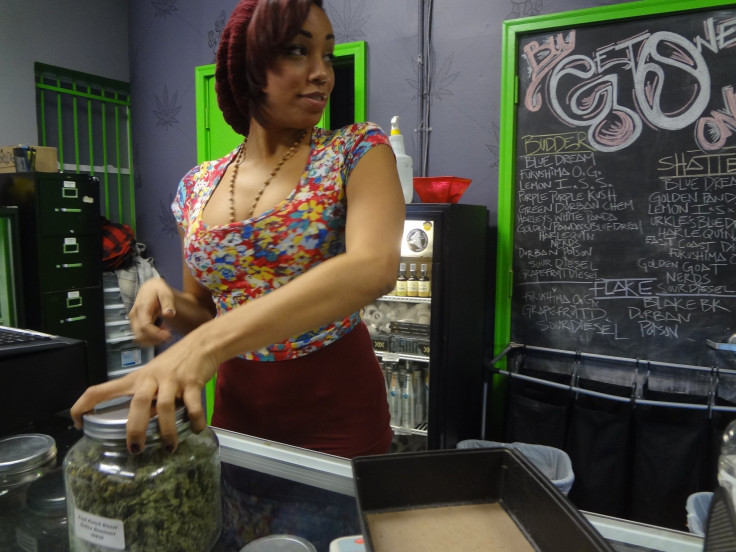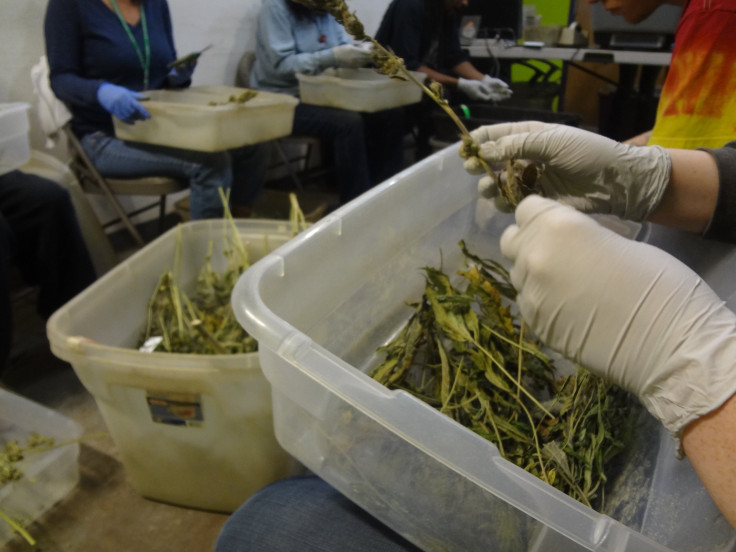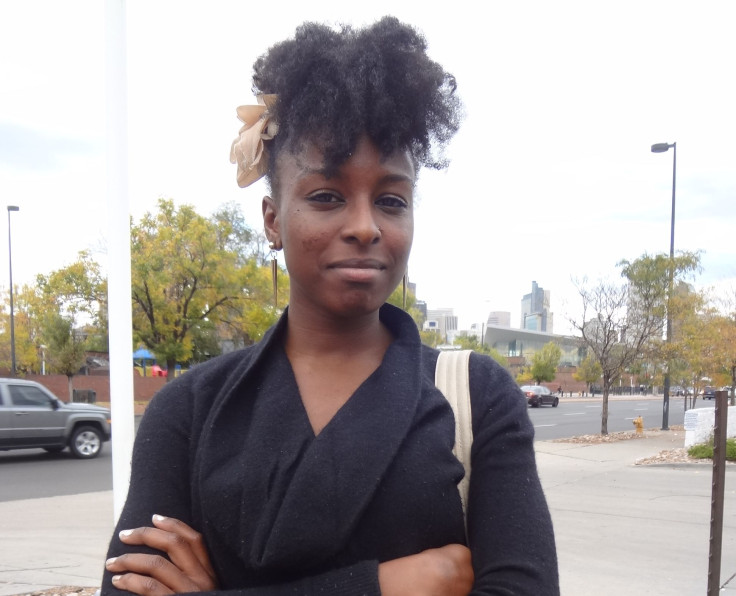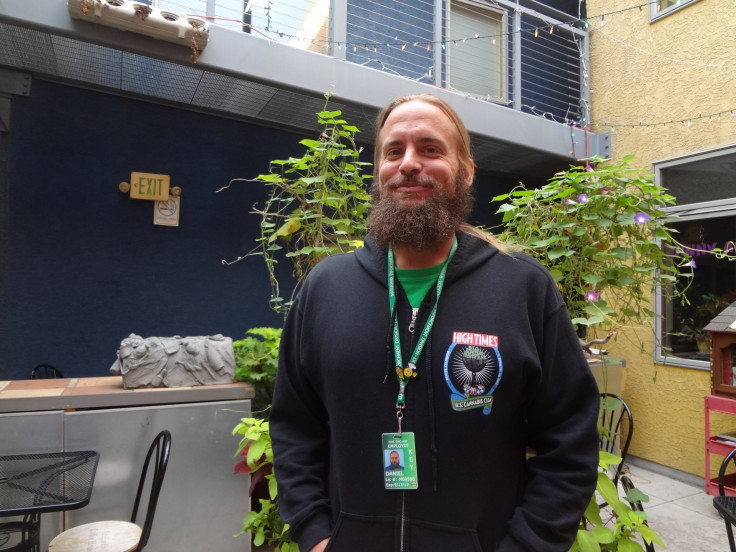Marijuana Employees Ask To Be Treated With The Same Respect As Their Merchandise

DENVER — “This is my favorite right now: Grapefruit Diesel,” says Alana Walker, unscrewing the lid of a glass jar filled with marijuana buds so the customers she’s helping can sniff at the merchandise. For Walker, it’s been a slow 11-hour workday at the marijuana shop where she works, probably because of the snowy Colorado weather. Plus it’s always slower on the medical marijuana side of the operation, where she works, compared to the half of the store dedicated to recreational marijuana. That side is always packed with confused first-timers.
“We call it Club Med because it’s chill over here, crazy over there,” says Walker.
Everyone is always telling Walker she has the best job in the world. And yes, when she left a job at a company investigating medical insurance fraud four years ago (“I didn’t want to work for insurance companies that ruined people’s lives anymore,” she says) and started working as a “budtender,” as dispensary workers are called, it wasn’t simply because it paid several dollars more an hour than other service-industry gigs. It was also because the job seemed thrilling. “At the time, it was a novelty,” she says. “It was new, it was exciting.” But at this point, it’s just a job to her, a way to pay her way through college and pursue her interest in music.
Plus, Walker has seen enough to know working in the weed business is far from perfect. She left her first budtender job because the operation cut too many corners; she was always losing hours because the business failed inspections and had to close temporarily. She’s happier where she works now, but there are still challenges. Like most workers in the cannabis industry, she doesn’t have benefits. She worries that she’s pushing 30, since for budtenders, being young and pretty is often a top priority. And she knows that, even though she was never formally trained, if she slips up on any of the various ever-changing rules she has to follow, like accidentally selling more than a quarter-ounce of product at a time to out-of-state visitors, or completing a sale after 7 p.m., she could land the business in hot water and end up out of a job.

Even if she doesn’t screw up, Walker knows her continued employment is never guaranteed. “We are marginalized,” she says. “People assume it’s a job everybody wants to do, and employers treat us like we’re expendable. They feel like they can treat people who work in a dispensary a little poorer than if they worked at a normal business.”
In the booming legal marijuana scene, the folks at the top of the food chain get most of the attention – the “Pot Barons” bankrolling shops in Aspen and Seattle, the entrepreneurs hoping to develop the Facebook of cannabis. Far less notice is paid to those laboring the front lines of the industry: the growers, trimmers and budtenders earning an hourly wage. But in a business where improper production or sale of its key product could invite federal crackdowns, much is riding on those tending to and vending these all-important plants. And it’s increasingly clear that employees aren’t always up to the task, thanks to recent sweeping product recalls triggered by growers using unauthorized pesticides on their crops and marijuana shops getting cited for underage sales.
Despite these pressures, the world of marijuana workers may be the one corner of the cannabis industry where there’s a lack of regulations and oversight. Employees and outside observers say there’s lax surveillance of workplace conditions, little in the way of mandatory worker training and minimal protections to ensure proper employee treatment. So why is it that legalized marijuana is being carefully protected and regulated, while those in charge of its care say they’re being treated like weeds?
Risky Business?
Susan Chicovsky looks on as nine of her employees sit together in a small, windowless back room of a cannabis grow facility, carefully picking marijuana buds off dried stems. The funky aroma of their labors hangs heavily in the air. Chicovsky is the owner of Green Mountain Harvest, a 5-year-old harvest and trim company that grow-house operators hire to prepare their plants for sale. Chicovsky admits that trimming -- cutting away leaves, or manicuring the buds -- can be tedious work, but such services are in high demand. Chicovsky is currently booking her team of 76 Colorado-based trimmers -- all of whom have gone through her “Trimmer Training School” and start at $10 an hour -- several months out and is planning on going national.
Chicovsky stopped by this grow operation in an industrial stretch of Denver to check on a group of her trimmers. She’s pleased with what she sees. Her trimmers, six hours into a nine-hour workday, appear relaxed and happy. The grow-facility manager weighing their output seems to be treating them well. And the cannabis they’re working on looks clean and not too crumbly. Chicovsky would prefer that all trim operations be carried out in clean rooms with tables covered in food-grade butcher paper, but compared to some trimming situations she’s witnessed, this arrangement isn’t bad.
Chicovsky says some of her employees have ended up in emergency rooms after being exposed to marijuana infested with powdery mildew. One time, her trimmers encountered plants so infested with pests it was hard to see the buds. (“We’ll just make it into hash,” said the plants’ owners when she told them her workers wouldn’t trim their product.) Then there are the risks that are hard to spot. As an increasing number of Colorado marijuana products test positive for pesticides, Chicovsky is concerned that her workers are being exposed to dangerous chemicals.

Chicovsky insists the vast majority of Colorado's legal marijuana operations are safe and professional. But she’s concerned about the risks those that aren’t pose for her employees – especially since hardly anyone else is looking out for them. When she set up her trimming company in 2010, she says Colorado’s marijuana enforcement officials told her trimming wasn’t something they’d thought much about, and she says not much has changed five years later. While the federal Occupational Safety and Health Administration is supposed to monitor workplace conditions in jobs like this, Chicovsky says that when it comes to marijuana trimming, “OSHA is not involved.”
While working in marijuana isn’t as dangerous as say, construction or farming, there are perils. Employees in grow facilities face electrical and fire hazards, not to mention possible pesticide exposure. At marijuana extraction operations, butane-triggered explosions have led to injuries and, at illegal labs, several deaths. Along with potential contact with chemicals and mold, trimmers can suffer ergonomic injuries from repetitive hand motions. And even budtenders face the minor but still debilitating hazards of service-industry jobs, but without the long-established safety precautions of traditional jobs like restaurant workers and bartending.
“It’s not unlike other small businesses,” says Mike Van Dyke, chief of environmental epidemiology for the Colorado Department of Public Health and Environment. “They spend all their resources trying to stay in business. And occupational health and safety isn’t seen as a No. 1 way to stay in business.”
It doesn’t help, adds Van Dyke, that worker conditions haven’t been a top priority as officials around the country struggle to regulate an industry that’s never existed before. “You have a lot of regulations around controlling inventory and making sure it doesn’t go out the back door and a lot of regulations on how pesticides are applied, but then [on working conditions] it goes over to OSHA, and I don’t think people are getting good direction on how to follow OSHA regulations,” he says.
Herb Gibson, area director of OSHA’s Denver Area Office, says his staff treats marijuana businesses just like any other industry. But as in all but the most dangerous workplaces the agency oversees, such as those in the oil and gas industry, OSHA hasn’t developed marijuana-specific guidelines or undertaken proactive inspections. “Likely the only way we have ended up at one of these facilities is if a worker makes a complaint,” says Gibson. That’s happened about 10 times since Colorado’s recreational marijuana system launched on Jan. 1, 2014, he says – and none of the recent complaints were related to workplace fires or employee hospitalizations.
Plus, adds Gibson, thanks to thorough licensing procedures for marijuana businesses, “They are regulated substantially more than other industries we inspect.”
Still, some believe more protections are needed. Marty Otañez, a University of Colorado Denver anthropology professor, has immersed himself in the marijuana industry, obtaining a state-issued marijuana employee badge and attending Green Mountain Harvest’s Trimmer Training School. He has major concerns about workplace conditions and the lack of federal efforts to address them. “This is a super new industry with very few parallels in recent history,” he says. “OSHA can more fully meet its mission by being proactive and developing protocols and policies that bring clarity to the relevant standards, specifically in regards to education on best practices associated with personal protective equipment and levels of risks associated with pesticide exposure and powdery mildew.” To that end, Otañez crafted a mock governor’s proclamation to make April 2016 “Cannabis Workplace Health and Safety Promotion Month.”
While there’s no indication that any governors will recognize cannabis workers as part of next year’s 4/20 marijuana celebrations, efforts are underway to tackle workplace safety. Since last April, the Colorado Department of Agriculture has held seven seminars where more than 400 attendees have learned how grow facility operators can comply with the Federal Worker Protection Standard, regulations designed to protect agricultural workers from pesticide exposures. And this summer and fall, the National Institute for Occupational Safety and Health, which conducts workplace injury research, repeatedly visited a medical marijuana farm in Vancouver, Washington, after its owner requested the inspections. The resulting Health Hazard Evaluation report, expected out in mid-2016, may be used to develop risk-mitigation procedures for the industry. “The reports are public, so if there are farms or processing plants that are interested in it, that is a great benefit of it,” says NIOSH spokeswoman Christina Spring.
Finally, at the Colorado Department of Public Health and Environment, Van Dyke is spearheading an effort to produce a best practices guide for occupational health and safety in the marijuana industry, covering everything from when workers should wear safety glasses to proper trimming procedures. “We felt this was really a Colorado issue,” says Van Dyke. “I don’t expect OSHA or NIOSH to put a lot of resources into providing guidance to these groups, so we felt it was our responsibility to figure out what workplace practices should be.”
Marijuana 101
“True or false: Edibles affect everybody the same.”
Maureen McNamara, founder of Cannabis Trainers, throws the question out to the dozen or so students attending one of her Sell-SMaRT classes, designed to teach budtenders and other marijuana store workers the ins and out of the industry. This particular query is relatively easy – edibles don’t affect everyone the same way – but many of the topics covered by McNamara during this five-hour seminar aren’t so simple.
By the time the session wraps up, attendees – who range from 20-somethings with purple hair and nose rings to older folks in professional dress – will have received a crash course in laws on driving with open marijuana containers, the specifics of validating various state IDs and international passports, the importance of client confidentiality, the basics of using marijuana concentrates, the science of THC absorption, the mathematical calculations needed to determine the maximum amount of product someone can buy at a time, the proper terminology to use for edibles (state rules insist on terms like “confection,” “lozenge” and “hard edibles,” but not “candy”) and many other topics.

The thoroughness of the course makes sense; being a budtender is far more complicated than many service-industry jobs. Along with knowing relevant state laws and avoiding underage sales, as bartenders and liquor store workers must, front-line marijuana employees also have to be experienced with inventory tracking systems usually reserved for people like bank tellers. Plus they are expected by many customers to provide the sort of medical advice associated with pharmacists.
And when these workers make a mistake — such as selling to an underage customer or passing some product out the back door to a buddy — the consequences could be serious. The U.S. Justice Department has indicated that only marijuana programs that follow a rigid list of rules, such as avoiding sales to minors and preventing marijuana from going to the black market, will avoid prosecution.
Despite the complexities and responsibilities of the job, in Colorado there are no training requirements to become a budtender. Most attendees of McNamara’s Sell-SMaRT classes are workers whose employers are paying their tuition. Colorado’s Marijuana Enforcement Division recently launched a Responsible Vender Program, in which marijuana shops whose employees are trained by a state-approved program such as McNamara’s face lower penalties for rule violations and may get insurance discounts. But at this point, the program, authorized by state legislation, is voluntary.
Other jurisdictions are moving toward compulsory worker training regimens, however. Several states that recently launched or are in the process of developing medical marijuana programs, including Nevada and Maryland, require employee training, and Washington state passed new medical marijuana rules that, among other things, will make worker education programs mandatory. While Washington’s new training requirements won’t extend to its nonmedical marijuana program, budtenders in Oregon’s recreational program will soon have to pass a state-administered employment test.
It’s about time employee training became a top priority, says Hilary Bricken, lead attorney at the Canna Law Group in Seattle. As she puts it, “It’s irresponsible that the states handle this product like it’s some hybrid of toxic waste and gold bricks, like this is contraband, but they do very little to make sure those handling it are meeting high standards.”
Worked To The Bone
Bridgette Marlow got a job as a Denver budtender in 2013 after attending a marijuana job fair. “This sounds interesting,” she remembers thinking. “I can sell weed.”
Two years later, after working at three dispensaries, she’s out of the business for good. “It made me hate weed,” she says. Her departure wasn’t due to workplace hazards or improper training; it was because she found the job utterly draining.

At times the work was incredibly stressful. There were always new rules and state-mandated product packaging to learn about, and there was always pressure to sell. “We were always being watched,” she says. “There were cameras everywhere. We needed to push out weed.” She says one of her managers fell into major drug use because of the pressure; another worker had a panic attack.
Despite the pressure and long hours, benefits were nearly impossible to come by. While her $12 hourly wages weren’t bad for the service industry, the sort of tips that bartenders, waiters and baristas rely on to supplement their incomes are rare at marijuana shops. And while employers seemed happy to have young, attractive women staffing their sales counters (“One manager said, ‘We would get fired if we hired an ugly girl,’” says Marlow) promotions were unlikely, since management jobs seemed reserved for guys and their buddies. “Everyone higher up was male,” she says.
While studies have suggested that women hold more executive jobs in the cannabis industry than the national average, sexism in the marijuana scene has a long history, says Kayvan Khalatbari, co-founder of Denver Relief, a marijuana dispensary and consulting group. “We had a male-dominated culture when it was all underground, and that sexism has been perpetuated,” he says. “I also think there is still a misconception that males are primarily the consumers here as well. And people are trying to take advantage of that from a sales opportunity.”
Daniel Henrickson hasn’t had to contend with sexism in his five years working in various Colorado trimming jobs, but he does have other complaints. Like Walker, he’s concerned about low wages, no job protection and a high-pressure work environment. The lack of health insurance is especially troubling, considering he’s HIV-positive. But at this point, he feels he has to stay in the cannabis business. “I have no choice,” he says. “After working in this industry, it’s really hard to go apply at Target for a job. They look at what you are doing and say, ‘Stoner.’”

The lack of employee benefits, the low wages and job insecurity could be causing one of the main problems regulated marijuana programs are seeking to avoid: diversion of legally grown marijuana to the black market. That’s the conclusion of Lia Berman, an anthropology grad student at the University of South Florida who spent three months working at a Colorado dispensary as part of her thesis project — where she regularly saw marijuana being sold under the table. “The low wages in many ways caused a lot of this product to be sold in informal networks out of economic desperation,” she says. “I was supporting myself greatly through my own funds; I would never be able to survive working 40 hours a week at a dispensary.”
The nature of the business can make it difficult for marijuana workers to speak up about unfair working conditions, says Jeff Ferro, head of the United Food and Commercial Workers union’s Cannabis Workers Rising campaign. “A lot of people in this industry have spent a lot of time avoiding law enforcement,” he says. “I think that translates into workers being afraid of complaining because it might cost them their job, not because of their employer, but because of the government.”
The UFCW has been working to organize cannabis members for years, but the unstable, quasi-legal nature of the business has made it difficult for the union to establish lasting contracts. So now Ferro and his colleagues are redirecting their efforts to ensuring that marijuana advocates include workers' rights provisions in legalization initiatives and not just look to the National Labor Relations Board to handle employee complaints. For while the NRLB ruled in 2014 that marijuana enterprises fall within its jurisdiction, Ferro says “the NRLB has not traditionally worked for workers in the last few years.”
Still, Ferro is optimistic that marijuana employers are willing to embrace what’s best for their workforce. “Right now, most of these people are still starting off as young entrepreneurs, and they see their employees as family,” he says. “We are working with a lot of them as true partnerships. It’s the best of labor-management relations.”
Henrickson, for one, is ready for those partnerships to benefit him and his co-workers. “I am watching these people get rich, and we’re all just getting used,” he says. “I know how much you're paying for your licenses, how much you’re paying for your electricity, how much you’re paying for your nutrients. Don’t tell me you’re not making any money. And yet they work us to the bone.”
© Copyright IBTimes 2025. All rights reserved.






















